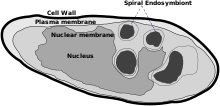|
Parakaryon
Location of Myōjin Knoll off the coast of Japan, where the specimen was found Parakaryon myojinensis, also known as the Myojin parakaryote, is a highly unusual species of single-celled organism known only from a single specimen, described in 2012. It has features of both prokaryotes and eukaryotes but is apparently distinct from either group, making it unique among organisms discovered thus far.[1] It is the sole species in the genus Parakaryon. EtymologyThe generic name Parakaryon comes from Greek παρά (pará, "beside", "beyond", "near") and κάρυον (káryon, "nut", "kernel", "nucleus"), and reflects its distinction from eukaryotes and prokaryotes. The specific name myojinensis reflects the locality where the only sample was collected: from the bristle of a scale worm collected from hydrothermal vents at Myōjin Knoll (明神海丘,[2] 32°06.2′N 139°52.1′E / 32.1033°N 139.8683°E), about 1,240 metres (4,070 ft) deep in the Pacific Ocean, near Aogashima island, southeast of the Japanese archipelago. The authors explain the full binomial as "next to (eu)karyote from Myojin".[1] StructureParakaryon myojinensis has some structural features unique to eukaryotes, some features unique to prokaryotes, and some features different to both. The table below details these structures, with matching traits coloured beige.[1][3]
InterpretationsGenuine species or artifactYamaguchi et al. proposed in their 2012 paper[1] that there were three reasons why the specimen they named P. myojinensis was not simply a result of parasitic or predatory bacteria living within another prokaryote host, which they acknowledged is known from several examples:
In 2016, Yamaguchi et al. detailed the discovery of helical bacteria on polychaetes collected from the same location, which they named "Myojin spiral bacteria".[4] In 2020, Yamaguchi and two others published a new short paper on their studies of the microbiota of polychaetes from Myojin Knoll. The authors stated "Among them, we often observed bacteria that contained intracellular bacteria on ultrathin sections." They studied one such specimen and concluded that the "host" bacterium was dead and its cell wall broken. The smaller bacteria could have been feeding on the larger bacterium but they also suggest "The association of the bacteria with dead bacteria could also have been artificially caused by the centrifugation steps used for the preparation of specimens for electron microscopy." In this paper, all five mentions of P. myojinensis were as a valid taxon with no implication that it is an artifact.[5] Evolutionary significanceIt is not clear whether P. myojinensis can or should be classified as an eukaryote or a prokaryote, the two categories to which all other cellular life belongs. Adding to the difficulties of classification, only one instance of this organism has been discovered to date, and so scientists have been unable to study it further. Its discoverers suggested that additional specimens would be needed for culturing and DNA sequencing to place the organism in a phylogenetic context.[1] British evolutionary biochemist Nick Lane hypothesized in a 2015 book that the existence of P. myojinensis could be the first known example of symbiogenesis outside eukaryotes, which could offer clues to the requirements for the development of complex life in general.[3] See also
References
Further reading
|
||||||||||||||||||||||||||||||||||||||||||||||||||||||||||||||

